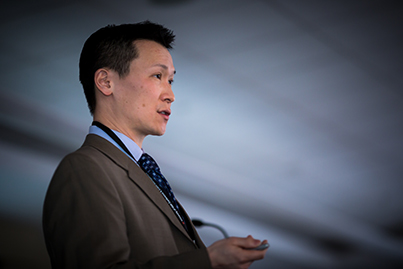
Author: The Office of Public Affairs
Robin Kim, MD, speaks at the Cholangiocarcinoma Foundation conference at the U.
Roughly 2,000 to 3,000 people in the United States will develop a rare and often fatal cancer—cholangiocarcinoma, which is cancer of the bile duct. If you are age 65 and older, you have increased risk for this disease.
This cancer is notoriously difficult to treat because it is aggressive and progresses quickly. Recently, experts from around the world gathered at the University of Utah to seek help and solutions for patients and their families. The Cholangiocarcinoma Foundation, in conjunction with Huntsman Cancer Institute’s Hepatobiliary Cancer Program, held its first national stakeholders conference on the University of Utah Campus.
This conference was the first of its kind,” said Robin Kim, MD, chief of liver transplantation at the University of Utah. “It concentrated on the needs of patients with this difficult disease while bringing together clinicians, researchers, and families to join in the fight of this emerging disease
This conference was essential in establishing a consortium to get hospitals to collect samples and share them in order to understand the molecular profiling of this cancer. According to Kim, the University of Utah was a logical choice for the conference because of its status as a certified transplant center for this type of cancer. “The union between the University of Utah and Huntsman Cancer Institute is powerful,” said Kim. “Together they can create strategies, employ awareness, therapy, and research.”
Bile duct cancer has been attributed to multiple risk factors. In particular, several conditions of the liver or bile duct may cause this disease including:
- Inflammatory bowel disease: this includes ulcerative colitis and Crohn’s disease. People with these diseases have an increased risk of bile duct cancer.
- Aging: older people are more likely that younger people to get bile duct cancer. Two out of three patients with bile duct cancer are older than age 65.
- Obesity: Being overweight or obese can increase the risk of developing cancers of the gallbladder and bile ducts. This could be because obesity increases the risk of gallstones and bile duct stones.
- Family history: A history of bile duct cancer in the family seems to increase a person's chances of developing this cancer, but the risk is still low because this is a rare disease.
- Viral hepatitis: Long term infection with either hepatitis B virus or hepatitis C virus increases the risk of intrahepatic bile duct cancers.
Symptoms of cholangiocarcinoma include yellowing of the skin and eyes (jaundice), intense itchiness of the skin and white-colored stools.
For more information about bile duct cancer, please contact Huntsman Cancer Institute’s Cancer Learning Center by calling 1-888-424-2100.